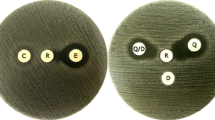Abstract
The in vitro susceptibility of ten strains ofFrancisella tularensis to four fluoroquinolones (ciprofloxacin, norfloxacin, ofloxacin and pefloxacin) was investigated by determining the MBCs of these quinolones. The results were as follows (mean ± SE): ciprofloxacin 0.13 ± 0.03 mg/l, norfloxacin 0.24 ± 0.07 mg/l, ofloxacin 2.16 ± 0.78 mg/l and pefloxacin 0.51 ± 0.50 mg/l. These concentrations can be achieved in clinical practice. In addition, four tularemia patients were treated with an oral regimen of 750 mg ciprofloxacin b.i.d. and one patient with norfloxacin 400 mg b.i.d. The fever experienced by these volunteers vanished within a couple of days and they were able to resume normal work one week after receiving the antibiotics without any relapses later. These in vitro and in vivo results show that orally administered fluoroquinolones are promising antimicrobial agents for the treatment of human tularemia.
Similar content being viewed by others
References
Boyce JM Francisella tularensis (Tularemia). In: Mandell GL, Douglas RG, Bennett JE (ed): Principles and practice of infectious diseases. Churchill Livingstone, New York, 1990, p. 1742–1746.
Alford RH, John JT, Bryant RE Tularemia treated successfully with gentamicin. American Review of Respiratory Diseases 1972, 106: 265–268.
Kaiser AB, Rieves D, Price AH, Gelfand MR, Parris RE, Decker MD, Evans ME Tularemia and rhabdomyolysis. Journal of the American Medical Association 1985, 253: 241–243.
Dienst FT Tularemia. A perusal of three hundred thirty-nine cases. Journal of Louisiana State Medical Society 1963, 115: 114–127.
Evans ME, Gregory DW, Schaffner W, McGee ZA Tularemia: a 30-year experience with 88 cases. Medicine 1985, 64: 251–269.
Wolfson JS, Hooper DC Fluoroquinolone antimicrobial agents. Clinical Microbiology Reviews 1989, 2: 378–424.
Schoenknecht FD, Sabath LD, Thornsberry C Susceptibility tests: special tests. In: Lennette EH, Balows A, Hausler WJ, Shadomy HJ (ed): Manual of clinical microbiology. American Society for Microbiology, Washington, DC, 1985, p. 1000–1008.
Massey ED, Mangiafico JA Microagglutination test for determining and measuring serum agglutinins ofFrancisella tularensis. Applied Microbiology 1974, 27: 25–27.
Syrjälä H Peripheral blood leukocyte counts, erythrocyte sedimentation rate and C-reactive protein in tularemia caused by the type B strain ofFrancisella tularensis. Infection 1986, 14: 51–54.
Foshay L Tularemia: a summary of certain aspects of the disease including methods for early diagnosis and the results of serum treatment in 600 patients. Medicine 1940, 19: 1–83.
Dahlstrand S, Ringertz O, Zetterberg B Airborne tularemia in Sweden. Scandinavian Journal of Infectious Diseases 1971, 3: 7–16.
Author information
Authors and Affiliations
Rights and permissions
About this article
Cite this article
Syrjälä, H., Schildt, R. & Räisäinen, S. In vitro susceptibility ofFrancisella tularensis to fluoroquinolones and treatment of tularemia with norfloxacin and ciprofloxacin. Eur. J. Clin. Microbiol. Infect. Dis. 10, 68–70 (1991). https://doi.org/10.1007/BF01964409
Issue Date:
DOI: https://doi.org/10.1007/BF01964409




